Exclusive Videos And Interviews (Part 1)
In September 2012 we ran the very first Smashing Conference — friendly, valuable and inspiring community event — in a beautiful medieval building in our home town Freiburg, Germany. The conference was a huge success, and we haven’t anticipated the fantastic feedback we’ve received during and after the event.
All conference tickets and workshop tickets were sold out within weeks, and to bring the event closer to everybody we blogged live from the venue, and captured all talks on video. We had the pleasure of welcoming and interviewing many top-class speakers and well-respected experts from the Web design industry.
With the Holidays being so close we are happy to release videos of the talks along with exclusive interviews with speakers that we conducted during the conference. We are starting off with the first 3 talks - by Jeremy Keith, Rachel Andrew and Stephen Hay. More videos will be released in the next days, and we’ll feature them here, on Smashing Magazine as well.
The videos were taken by Frank Sippach, cut by Marc Thiele, the co-organizer of the event, and the interviews were conducted by Esther Arends and Melanie Lang from the Smashing Editorial Team. Subscribe to our events mailing list to stay updated about the next Smashing Conference and other upcoming Smashing events!
Jeremy Keith: The Spirit Of The Web
Jeremy Keith makes websites. He is responsible for the death of the trees used to print the books DOM Scripting, Bulletproof Ajax and, most recently, HTML5 for Web Designers. He also shot a man in Reno just to watch him die. Originally from Ireland, Jeremy now lives in Brighton, England, where he pretends to work with Clearleft. Peas grow there.
The Interview
Question: Hey Jeremy, thanks for taking the time for an interview. You lived here in Freiburg early in your career. What brought you here?
Jeremy Keith: Before I went to Freiburg, I was playing music on the street, and I also went to art college for a bit back in Ireland, but I dropped out.
I came to Freiburg because a friend of mine studied here and told me that I should visit. So, I did and eventually moved here. That was around the early to mid ’90s. I was working in a German bakery selling bread, Brezels and all that good stuff. I really miss German baked goods. When I learned German, all of my vocabulary was bread-based. I knew German words for things which I couldn’t even name in English.
Question: Where was your flat?
Jeremy: It was just by the Stadtgarten. The address was Stadtstraße 1. It was a basement flat, which wasn’t pretty but very central.
Question: You also met your wife, Jessica, here, who is not originally from Freiburg either. How long did you live in Freiburg?
Jeremy: Jessica is American and came to Freiburg because she studied German and wanted to do her year abroad. We played in a band together. She extended for another year but then had to go back and finish her degree in the States for another year. I also went over to visit her, and when she was finished we moved back. So, I lived here around six years, but I also lived in the USA in between that.
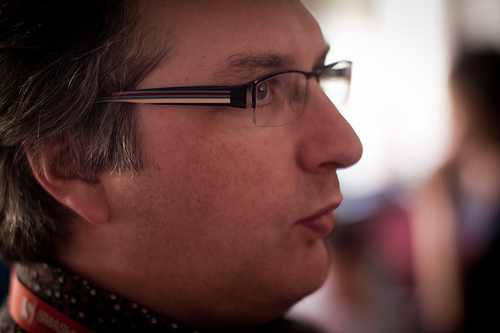
Jeremy Keith at the Smashing Conference. A photo by John Davey.
Question: You also played music in Freiburg? What kind of music did you do?
Jeremy: The band was more rock but with a bit of folk influence. People didn’t really know what to make of it. Later, the band went with us to England, and we were much better there.
I was also playing bass in the best surf band of the Schwarzwald (Black Forest), called Leopold Kraus Wellenkapelle. They’re actually still going and got a lot better when I left. But it was a lot of fun playing with them.
Question: Where was the most inspiring place for you in Freiburg?
Jeremy: The Freiburger Münster. I think I’m still a member of the Münsterbauverein, an association to fund the upkeep of the building. There is a lot of cool stuff in it. Have you seen the carvings in the stones in the front? It shows the shapes of circles, bread loaves and stuff like that. They’re measures of certain things so that people would know how big those things had to be. Those where the standards back in the day. You can even see the wealth of certain times. In poor times you had smaller measures than in better ones.
I also think about hanging out at the Augustiner Platz, having a beer, playing guitar, singing along. This is so different from England. In England, there would be a fight at some point, because it’s such a different drinking culture. The English get rowdy and want to let you know that they are really drunk. Here, people just have a few drinks and relax.
It was a shame that Ganter was the beer of Freiburg because it’s not the best. Tannenzäpfle was really nice. Back in the day, Tannenzäpfle used to be the secret of the Schwarzwald (Black Forest); now it’s actually become a trend beer. On the plus side, we might start seeing it in England. I had withdrawal from good beer when I moved to England.
And there is another fun thing in Germany. Why do you have just one flavor of crisps? It’s always paprika, paprika, paprika.
Question: Um, but now we have whole range of flavors. I like the plain salted ones, for example.
Jeremy: Yeah, but it’s always paprika. Even the salted ones taste like somebody licked a paprika.
Question: Hmm, I wouldn’t know the answer to this. What was your impression of Freiburg in general?

Grilled German sausage from the farmer’s market at the Münsterplatz. Yummy!
Jeremy: Freiburg is pretty for the most part. I love the Münster and the market around it. I didn’t really appreciate it when I was living here. Now I look around and think this is really amazing. It’s a student town, and back then there was a really good music scene here. I remember how it was in the old Vauban. [Vauban is a part of Freiburg known for its alternative character. It was rebuilt as a sustainable model district starting in the mid-’90s –Ed.]
I also miss the wine because it doesn’t get exported. I definitely will be stocking up on some Spätburgunder. The white wine is very nice here, even though I normally prefer reds.
Question: You started doing Web design here. How did you start?
Jeremy: Around the mid to end of the ’90s, we decided that our band should have a website because everyone had one. We already had an email address, and we were very proud of that, but no website. I said I would look into making it, because Jessica had a computer and I had been on the Web.
An old friend of mine who had been to art college with me was in the States, and I knew he was doing something with computers and probably with the Web. I knew that you needed Photoshop to design, so I thought that if you wanted to do Web design you’d need some other flashy expensive software, and I asked him about what I should use.
He said that I should open up a text editor and type in some HTML, save the file, and it will open in a browser. I tried and it actually worked! It was amazing—I couldn’t believe it. It was like when I was a kid just using the computer. You play around, something happens, and you feel so powerful. Considering that our band website was my first one and that it was the ’90s, it wasn’t too bad. It was 640 × 480 pixels.
I was never interested in Irish music when I was in Ireland, but I got into it when I came here. After finishing the band’s website, I didn’t know what else to do with my fresh HTML knowledge, so I decided to share Irish music. I started a site called The Session. Initially, it was just me posting one tune a week. This was actually better than posting everything at once. And I was able to add comments. This was a big deal back then, because before you had PHP, you had to write Pearl scripts. But it actually taught me how to program. Later, I learned how to create databases and so on. That project is actually still going. It’s changed, but it’s still going. It needs a redesign, which I’m working on right now.
I like having a long-term project going on. The Session has been going on for 10 years now, and it’s great because, in Web terms, this is forever. A lot of times, things on the Web go very fast. They are here today, gone tomorrow. And people forget this. People talk about Facebook like it’s always going to be there. But they also thought that Friendster would be there forever.
After my first website, people started asking me if I could do their website, so I started freelancing. I got more work and quit working at the bakery. Not long after that, we moved to Brighton, and until today I hadn’t been back to Freiburg in 12 years.
I only came to Freiburg by accident. When I look back, it was like it all came together when I started Web design. I didn’t know what to do otherwise. I played music, but I wasn’t very good, and I wasn’t really good at art college. It was like I was waiting around until the Web was invented.
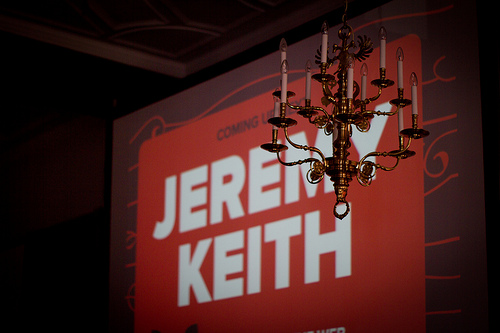
Jeremy Keith is coming up next. A photo by John Davey.
Question: Why did you decide to move to Brighton?
Jeremy: As I mentioned before, Jessica and I played in this band. Our singer decided that he should finish uni because he never graduated. But he didn’t want to do it in Germany because back then it took much longer than in the UK. So, he went back to England and studied in Brighton. I thought that would be it with the band. He asked us to visit, which we did, and thought that it was a very nice place. At that point, we also got a bit tired of Germany, so we checked out Brighton. And then a flat became available in the same building where our singer lived, so we decided to move there.
We actually didn’t move because of the Web scene or anything. But once we got there, we found a lot of good stuff going on. I found people who were blogging, and I met people in real life who were doing the same stuff as I did.
Now, Brighton is — as Andy Clarke puts it — the center of the universe. There are many smart people and a lot of great stuff — for example, the Brighton Digital Festival, which consists of many events. If you consider the size of the city, it’s amazing how much is going on.
Question: How did Brighton become so special?
Jeremy: I don’t think there is any special reason for it. It’s more like this self-perpetuation circle. Now, people come down here because of the scene. Kevin Kelly made up this term, “scenius.” There is no particular reason why a scene manifests in one place. It just starts at some point; then it gets this positive feedback and develops. But that could be anywhere. A lot of factors play into it, like the fact that it’s a student town with many young people. It’s a good place now, but I don’t think you could guess those things and reproduce it.
Question: Do you see a difference between Freiburg and Brighton?
Jeremy: There definitely is. Freiburg is really lovely, and Brighton I wouldn’t describe as lovely at all. There are towns in England which are very picturesque and lovely — towns where you would bring your mother and have a lovely time. And Brighton is not one of those. It’s actually a bit seedy, sleazy, scuzzy and dirty. But because of that, it’s also active, and a lot of stuff is going on.
Freiburg doesn’t have a sleazy side to it. It’s amazing how little has changed in 12 years. When I’m two weeks away from Brighton, there will be new stuff everywhere when I get back. Freiburg is much more steady and calm in this respect.
Brighton is hectic, but way less than, for example, London, which is far too extreme. Sometimes I tend to feel that Brighton is hectic. But then I come back from a day in London, and when I get off the train, I see Brighton as such a sleepy seaside town. So, it always depends on what you compare it to.
Question: What are some must-do’s in Freiburg? And in Brighton?
Jeremy: The Freiburger Münster, and the farmer’s market which takes place in front of it every morning. Another great thing is to sit at the Haus der Badischen Weine (House of the Baden Wines), eat fruit from the market and drink a glass of Neue Süße (a German speciality –Ed.).
When you visit Brighton, you have to see the Royal Pavilion. It’s such a tacky building. It looks like the Taj Mahal and makes you think, “What is this doing in an English town?” It was originally build for sex, feasts and things like that. The interior design completely looks Chinese, except that the guy who came up with it had never been to China. There is also the pier, which is a bit overrated, but you probably should go there once. You can also stroll around the North Laine and find a lot of great coffee shops around there. It’s also great to go to the beach and just hang out there when the weather is nice.
As a geek, you should time your visit right, because the chances are good that some event or meetup will be taking place during your stay. There is always something on, and you should meet the local guys and hang out with them.
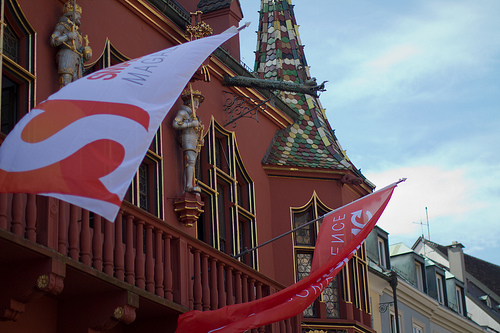
Smashing Flags outside the conference venue. A photo by John Davey.
Question: In your speaker’s biography at the Smashing Conference, you included the sentence, “He also shot a man in Reno just to watch him die.” What is this about?
Jeremy: It’s just a line from the song Folsom Prison Blues. When you speak at conferences, you’re supposed to make up your own bio — and even then in the third person. So, I say stuff like that, which I make up. I also kind of have an ongoing thing with job titles. I come up with a new one every two weeks. On the Clearleft website, there is a list of all of the staff members and their titles, such as UX director and lead creative strategist. I just put in names like King of Brighton or Long-Time Super Genius. It looks ridiculous, and it sort of makes the other titles look ridiculous, too, which is my point because I’m not a fan of job titles. Senior Lead Creative Manager — that’s another one. What does that even mean?
Question: How are you enjoying the conference so far?
Jeremy: I feel a bit behind because I’ve been sneaking out a lot to enjoy the market. But I haven’t been here in so long, so I just had to do that.
I like that it’s a single-track conference and that design and development are mingled. I really dislike multi-track conferences, especially when design and development are separated. What happens is that both groups just go to the topic they already know about, whereas in a single-track conference you have this shared experience. Designers and developers can learn from each other and will understand each other way better when collaborating on a project.
I like that you can go to the market and just have local food. I know how much catering adds to the ticket price, so I think that is a lot better.
The Wi-Fi was up and down, but I wouldn’t judge a conference on its Wi-Fi. Vitaly and Marc encouraged people to tweet, but I just don’t see the point of it, to be honest. You have to be here; you don’t get any real impression of it from 160 characters. Blog posts instead are great because the author can state what they learned or what bits inspired them. So, I’m more a fan of that.
The line-up is great, the talks are good, and the speakers great. There is no shortage of smart people in this industry. A lot of them really know their stuff, but it’s tricky to be on stage. Not many people are able to speak on stage and express their technical skills — this is a wonderful skill. It doesn’t matter how smart you are: you have to be good at making it entertaining and interesting for the audience. So, here we have those people.

A Smashing audience, attentively listening.
Rachel Andrew: The Future Of Content Management
Rachel Andrew is a front- and back-end Web developer, author and speaker. Her books include the bestselling CSS Anthology for SitePoint, and she is a regular contributor to a number of publications both online and off, including Smashing Magazine. She writes about business and technology on her own website.
Question: You seemed pretty nervous before you went on stage, how was it to be part of the first Smashing Conference?
Rachel: I’ve written for Smashing Magazine before and I was really pleased to be asked, especially along with the other people who are real stars. I’ve done a new presentation here, so it’s always a bit scary to see how the slides will go and what people think. But I think it’s gone pretty well.
Question: Have you been on many conferences this year? Is there anything special about the Smashing Conference?
Rachel: Yes, I have been all over the place this year. The venue here is amazing. It’s real cool to be at someplace so exciting, and it’s warm and very friendly. It’s been like coming and meeting up with a lot of friends.
Question: In your talk you talked about content management system and CMS nightmares. What was your biggest CMS nightmare?
Rachel: It was one where the client insisted on doing something which we knew was going to damage that content and we told him that. But in the end we gave up. To actually give someone something which we we don’t think is right — I just hate that. I want to give clients great solutions. But if you can’t explain why something is a better solution, there is nothing you can do about it.

Rachel is speaking at Smashing Conference.
Question: You developed your own CMS, called Perch. For what sort of projects is Perch great?
Rachel: We designed Perch for smaller sites. We assumed it would be used for websites with five to six pages. Launching Perch 2.0 was really a response to the fact that people who were using it used it for much bigger sites. It’s still fairly simple but we made changes to support people who want to use it on bigger sites.
Question: Is Perch only good for regular websites, or can you also use it for blogging?
Rachel: We’ve got a blog add-on. One of the improvements we’re looking at is an import function for importing WordPress content if people want to move over. We’ve got add-ons for various things like for a blog or events. We create more plugins and add-ons as we go along.
Question: Beside Perch, do you have a favorite CMS?
Rachel: Before we coded Perch we did a lot of custom work for clients because there was often nothing which really fit for the projects. For me everything is great as long as it works for the job you’re doing. But if you insist on only using a certain CMS and try to force everything into it — that’s when you run into problems.
Question: What is one of the main future challenges which CMSs are facing?
Rachel: In my opinion things like the responsive images problem is a challenge for the future. It’s something which every CMS developer should look into. It’s going to be interesting to find solutions for this problem and media content in general.
Stephen Hay: Style Guides Are The New Photoshop

Stephen hay on stage. Image by Littlemad.
Stephen has been designing and developing for the Web since 1995. He currently helps clients with front-end design and development, multi-platform strategy and accessibility through his consultancy, Zero Interface. He is co-organizer of Mobilism, one of the world’s leading mobile Web development conferences and co-creator of Grip Workshops, a series of two-day intensive workshops for Web project managers on the client side.
Stephen has written for publications including A List Apart and .net Magazine. He also contributed a chapter to the Smashing Book 3 with a host of super-talented folks. When he makes the time for it, he publishes his thoughts on The Haystack.
At the Smashing Conference we were able to ask humble Stephen a few questions about his work and his personal insights at the first Smashing Conference.
Question: Originally you studied and worked in print media. Why and how did you start doing Web design?
Stephen: I started doing Web design in 1995, so I kind of brought Web design into the company I was working for at that time. And then I just wanted to focus on doing Web design so I stopped doing print work.
Question: What makes Web design more exciting than print design?
Stephen: I like the fact that it keeps changing. I tend to get tired of things pretty quickly, so when things keep on changing, there is always something new to learn. And I love learning new things even though I may not use all of them. I like the speed of it all, it brings a lot of opportunities.
Question: You mentioned in your talk that unlike many designers, you don’t use Photoshop for creating Web design mock-ups. What do you use instead?
Stephen: It’s not that I don’t like Photoshop, I just don’t need it. I don’t own Photoshop. If I need image editing I use GIMP or Inkscape, but I only use them for image assets generally. I’m one of those who sketch on paper and I have a Bamboo tablet, so I sketch on a blank pad on the screen. But it’s still only sketching.
I also don’t use Illustrator or Fireworks. However, I do use Adobe Edge Inspect, which allows you to display your page on several devices while testing it, as well as taking screenshots on all these devices. Great stuff.
Question: What is your favorite tool or editor to create your mockups?
Stephen: The editor I work with is vim. I learned about it from a former employee. That was about eight years ago, and I hardly know anything about this editor because it’s so powerful and there is so much you can do with it. I’m faster than I used to be, but I still consider myself a beginner. I’ve seen people who are really, really fast in vim. What I like is that it is so powerful but you don’t see any of that power on the screen. It is just like a blank screen. There are no buttons, no menus, nothing. The commands are there, but you have to type them in, so they’re only there when you need them. Everything is done with the keyboard.
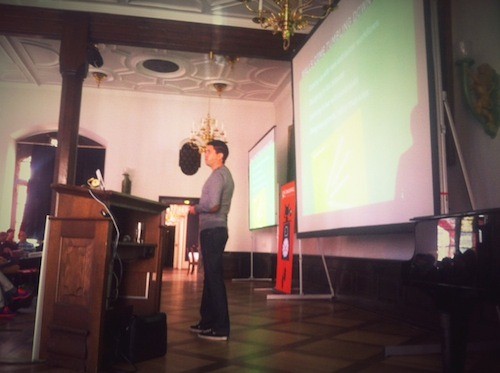
Question: Which keys or keyboard shortcuts in vim do you use mostly?
Stephen: Probably the movement keys. The H, J, K, L are used to move up and down and sideways. And also jumping from word to word with the W key.
Question: So is your work more about design or more about development?
Stephen: It depends on the project. There are plenty of projects where I do some of both. Sometimes, especially since I became an independent contractor, I’m just hired to advise clients on how they can approach specific Web-related problems. I ask them lots of questions and help them figure out what approaches they might consider regarding design and front-end development issues.
Question: Which coding or markup languages do you use for your projects?
Stephen: I use a little bit of JavaScript but I’m not a JavaScript hero by any means. I use mainly CSS and HTML.
Question: What is your favorite HTML element and what is your favorite feature in CSS?
Stephen: In HTML5, I really like the track element which will allow for adding things like subtitles to video. In CSS, I like everything that has to do with layout. Right now, I like what they are doing with flexbox. I love it, because it will change the way we lay out components on a page.
Question: How was it for you to be part of the first Smashing Conference?
Stephen: I feel honored and humbled. A lot of these speakers are people whose work I’ve admired and read about for the last eight to ten years. People like Andy Clarke whose thinking I’ve always respected. Almost everyone here (except from myself; I really feel like the odd one). But I really feel honored that Marc and Vitaly asked me to speak at their conference. It’s well organized, the location is beautiful and the city is gorgeous.
Question: Are you speaking at many conferences?
Stephen: I have done some conferences but not many. The Fronteers Conference in Amsterdam, Breaking Development in the United States and Mobilism, which I co-organize. I do a lot of speaking for clients. I’ve done several workshops and things like that. Much of that is related to Web accessibility; I’ve done a lot of accessibility-related work. There’s not much more on the agenda for now but I hope to do more speaking because I like doing it even though it is a lot of work and I get really nervous. But it is great fun to do (especially when you’re finished).
Question: Was there anything special for you at the Smashing Conference?
Stephen: It is still early, but what comes to mind immediately is the line-up of speakers. It’s almost the who-is-who of Web design and development brought to one place. This group of talent in one place… it’s just incredible. And the location… Freiburg is a beautiful, beautiful place.
Stay Tuned!
More videos and interviews will be presented on Smashing Magazine next weeks. Subscribe to our events mailing list to stay updated about the next Smashing Conference and other upcoming Smashing events.
Further Reading
- List Of Upcoming Web Design Conferences
- Smashing Conferences and Workshops
- How To Transform Conference Takeaways Into Real-Life Results
- Taking A Closer Look At Tech Conferences

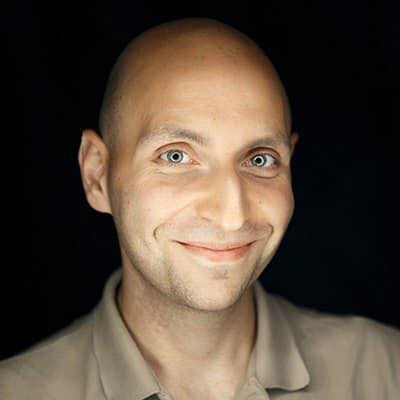



 Flexible CMS. Headless & API 1st
Flexible CMS. Headless & API 1st


